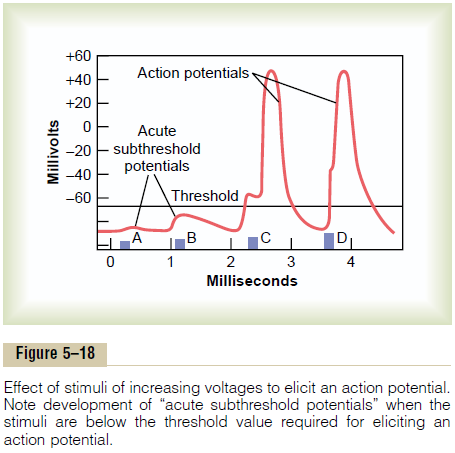Chapter: Medical Physiology: Membrane Physiology, Nerve, and Muscle : Membrane Potentials and Action Potentials
Excitation-The Process of Eliciting the Action Potential
Excitation-The Process of Eliciting the Action Potential
Basically, any factor that causes sodium ions to begin to diffuse inward through the membrane in sufficient numbers can set off automatic regenerative opening of the sodium channels. This can result from mechanical disturbance of the membrane, chemical effects on the membrane, or passage ofelectricity through the mem-brane. All these are used at different points in the body to elicit nerve or muscle action potentials: mechanical pressure to excite sensory nerve endings in the skin, chemical neurotransmitters to transmit signals from one neuron to the next in the brain, and electrical current to transmit signals between successive muscle cells in the heart and intestine. For the purpose of understanding the excitation process, let us begin by discussing the principles of electrical stimulation.
Excitation of a Nerve Fiber by a Negatively Charged Metal Electrode. The usual means for exciting a nerve ormuscle in the experimental laboratory is to apply elec-tricity to the nerve or muscle surface through two small electrodes, one of which is negatively charged and the other positively charged. When this is done, the excitable membrane becomes stimulated at the negative electrode.
The cause of this effect is the following: Remember that the action potential is initiated by the opening of voltage-gated sodium channels. Further, these channels are opened by a decrease in the normal resting electri-cal voltage across the membrane. That is, negative current from the electrode decreases the voltage on the outside of the membrane to a negative value nearer to the voltage of the negative potential inside the fiber. This decreases the electrical voltage across the mem-brane and allows the sodium channels to open, result-ing in an action potential. Conversely, at the positive electrode, the injection of positive charges on the outside of the nerve membrane heightens the voltage difference across the membrane rather than lessening it. This causes a state of hyperpolarization, which actu-ally decreases the excitability of the fiber rather than causing an action potential.
Threshold for Excitation, and “Acute Local Potentials.” A weaknegative electrical stimulus may not be able to excite a fiber. However, when the voltage of the stimulus is increased, there comes a point at which excitation does take place. Figure 5–18 shows the effects of successively applied stimuli of progressing strength. A very weak stimulus at point A causes the membrane potential to change from –90 to –85 millivolts, but this is not a suffi-cient change for the automatic regenerative processes of the action potential to develop. At point B, the stim-ulus is greater, but again, the intensity is still not enough. The stimulus does, however, disturb the membrane potential locally for as long as 1 millisecond or more after both of these weak stimuli. These local potential changes are called acute local potentials, and when they fail to elicit an action potential, they are called acutesubthreshold potentials.

At point C in Figure 5–18, the stimulus is even stronger. Now the local potential has barely reached the level required to elicit an action potential, called the threshold level, but this occurs only after a short“latentperiod.” At point D, the stimulus is still stronger, the acute local potential is also stronger, and the action potential occurs after less of a latent period.
Thus, this figure shows that even a very weak stimu-lus causes a local potential change at the membrane, but the intensity of the local potential must rise to a thresh-old level before the action potential is set off.
“Refractory Period” After an Action Potential, During Which a New Stimulus Cannot Be Elicited
A new action potential cannot occur in an excitable fiber as long as the membrane is still depolarized from the pre-ceding action potential. The reason for this is that shortly after the action potential is initiated, the sodium channels (or calcium channels, or both) become inactivated, and no amount of excitatory signal applied to these channels at this point will open the inactivation gates. The only condition that will allow them to reopen is for the mem-brane potential to return to or near the original resting membrane potential level. Then, within another small fraction of a second, the inactivation gates of the chan-nels open, and a new action potential can be initiated.
The period during which a second action potential cannot be elicited, even with a strong stimulus, is called the absolute refractory period. This period for large myelinated nerve fibers is about 1/2500 second. Therefore, one can readily calculate that such a fiber can transmit a maximum of about 2500 impulses per second.
Inhibition of Excitability—“Stabilizers” and Local Anesthetics
In contrast to the factors that increase nerve excitabil-ity, still others, called membrane-stabilizing factors, can decrease excitability. For instance, a high extracellular fluid calcium ion concentration decreases membranepermeability to sodium ions and simultaneously reduces excitability. Therefore, calcium ions are said to be a “stabilizer.”
Local Anesthetics. Among the most important stabilizersare the many substances used clinically as local anes-thetics, including procaine andtetracaine. Most of these act directly on the activation gates of the sodium chan-nels, making it much more difficult for these gates to open, thereby reducing membrane excitability. When excitability has been reduced so low that the ratio of action potential strength to excitability threshold (calledthe “safety factor”) is reduced below 1.0, nerve impulses fail to pass along the anesthetized nerves.
Related Topics